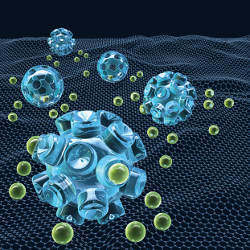(Nano Telecommunication) What ?? A nano- scale communication network (PhD in nano-microelectronics)
Researcher and author: Dr. ( Afshin Rashid)
Note: A nano-network is a nano- scale communication network between nano-devices. Nano-devices face certain challenges in performance due to limitations in the ability to process power management . Therefore, these devices are expected to perform simple tasks that require different and new approaches. Molecular telecommunications is a new information and communication solution that operates on the basis of biological mechanisms and systems. Two nanoparticles can communicate with each other through chemical signaling.
Data transfer between two nanoparticles can increase the capabilities and applications of nanoparticles compared to their single operating mode in both complexity and range of performance. This complex and flawless process with a wide coverage range can be called Nano (Data_Telecommunication) or Nano_Telecommunication. Regarding the communication structure between two nanoparticles through chemical signaling, their measurement performance requires that they be placed in an environment from which parameters must be measured, and the area covered by a nanoparticle is limited to the environment. Is around it. However, a network of communication nanoparticles can cover a wider area and perform more network processing . In addition, there are several nanotechnology technologies that They need to use external stimulation and measurement to work. The wireless connection between the nano-network and the micro and macro devices and equipment can meet this need.
A simple nanocommunication device consisting of a carbon nanotube that forms two electrodes. These connecting magnetic particles are exposed to various large molecules, causing some of them to attach to the surface of the carbon nanotube. In nano-telecommunications , different molecules give unique sound signals in relation to the properties of the molecules. The power of interaction between carbon nanotubes and molecules comes from noise signals. In nano-telecommunications, the interaction with electronic nanoparticles based on carbon nanotubes changes the signal produced by the carbon nanotube device following the adsorption of specific single molecules. This is because the adsorbent molecule creates a trap in the carbon nanotube, which conducts it.This means that carbon nanotube devices based on carbon nanotubes are very sensitive. And they can detect a unique amount of single molecules. The ability to describe single molecules using highly sensitive nanoelectronics is an exciting prospect for sensors, especially for neural applications and biosensors. The use of acoustic signals to identify molecular activity (interaction) or (active orbit) is attractive. In nanocommunication and interaction with electronic nanoparticles based on carbon nanotubes, the sensitivity of signal recognition may be increased through the production of controllable noise. These carbon nanotube-based nanocommunications show that it is possible to identify individual molecules through their unique noise particles in current nanocommunication signals. Improved knowledge of molecular origin and interaction with electronic nanoparticles based on noise nanotubes should lead to the development of electronics that use noise to improve their performance instead of destroying it.
Conclusion :
A nano-network is a nano- scale communication network between nano-devices. Nano-devices face certain challenges in performance due to limitations in the ability to process power management . Therefore, these devices are expected to perform simple tasks that require different and new approaches. Molecular telecommunications is a new information and communication solution that operates on the basis of biological mechanisms and systems. Two nanoparticles can communicate with each other through chemical signaling.
Researcher and author: Dr. ( Afshin Rashid)
PhD in Nano-Microelectronics




